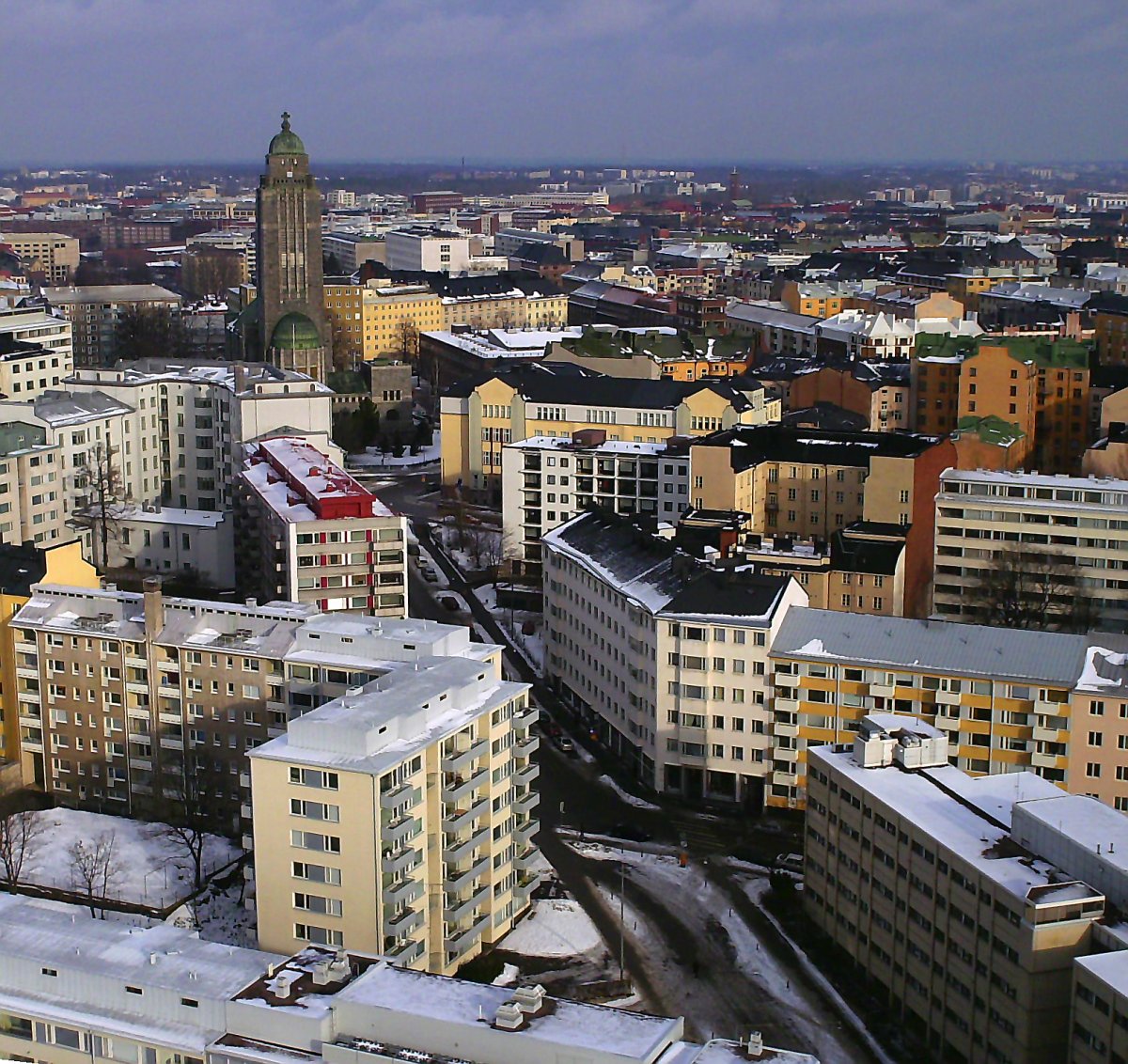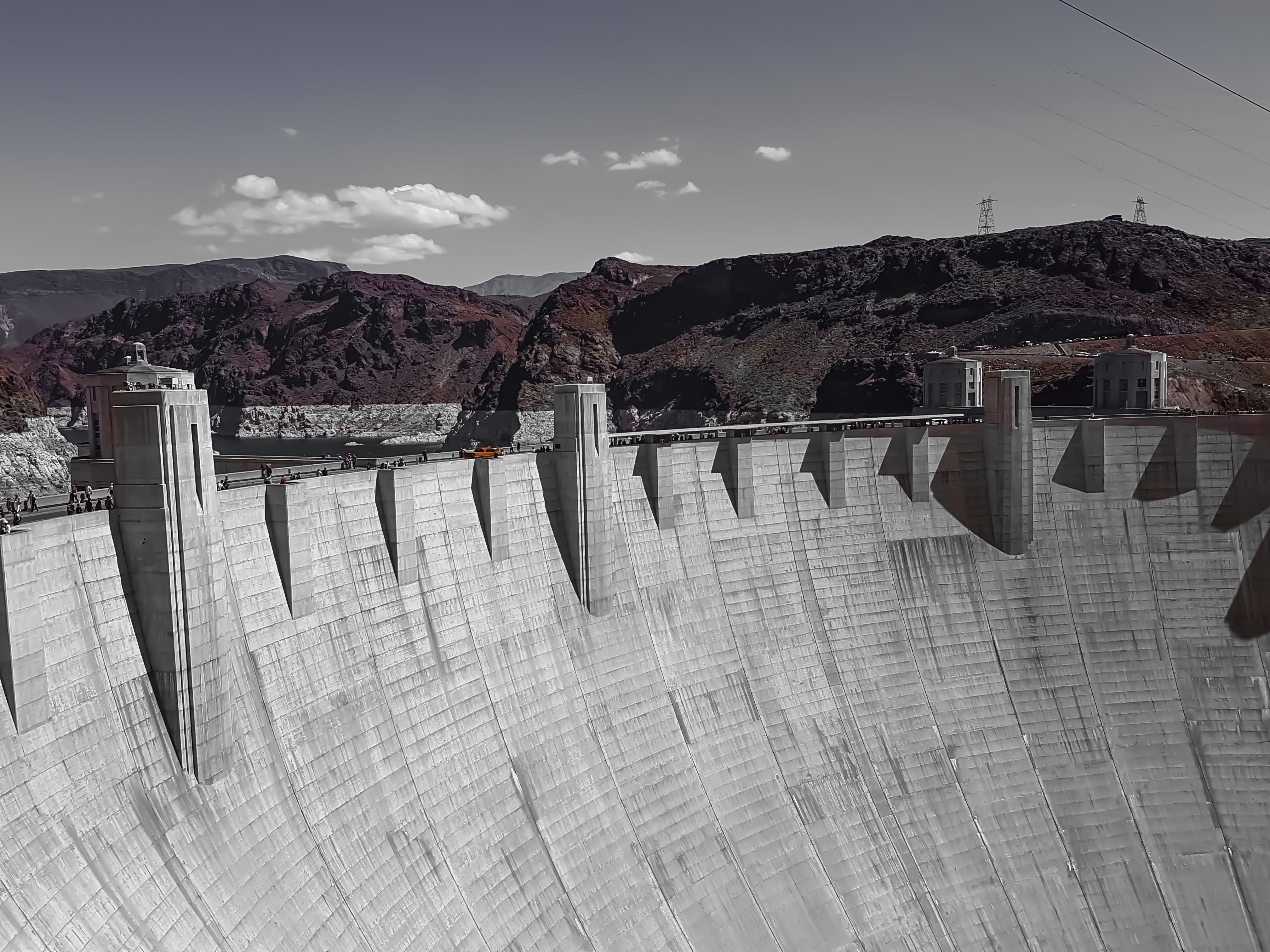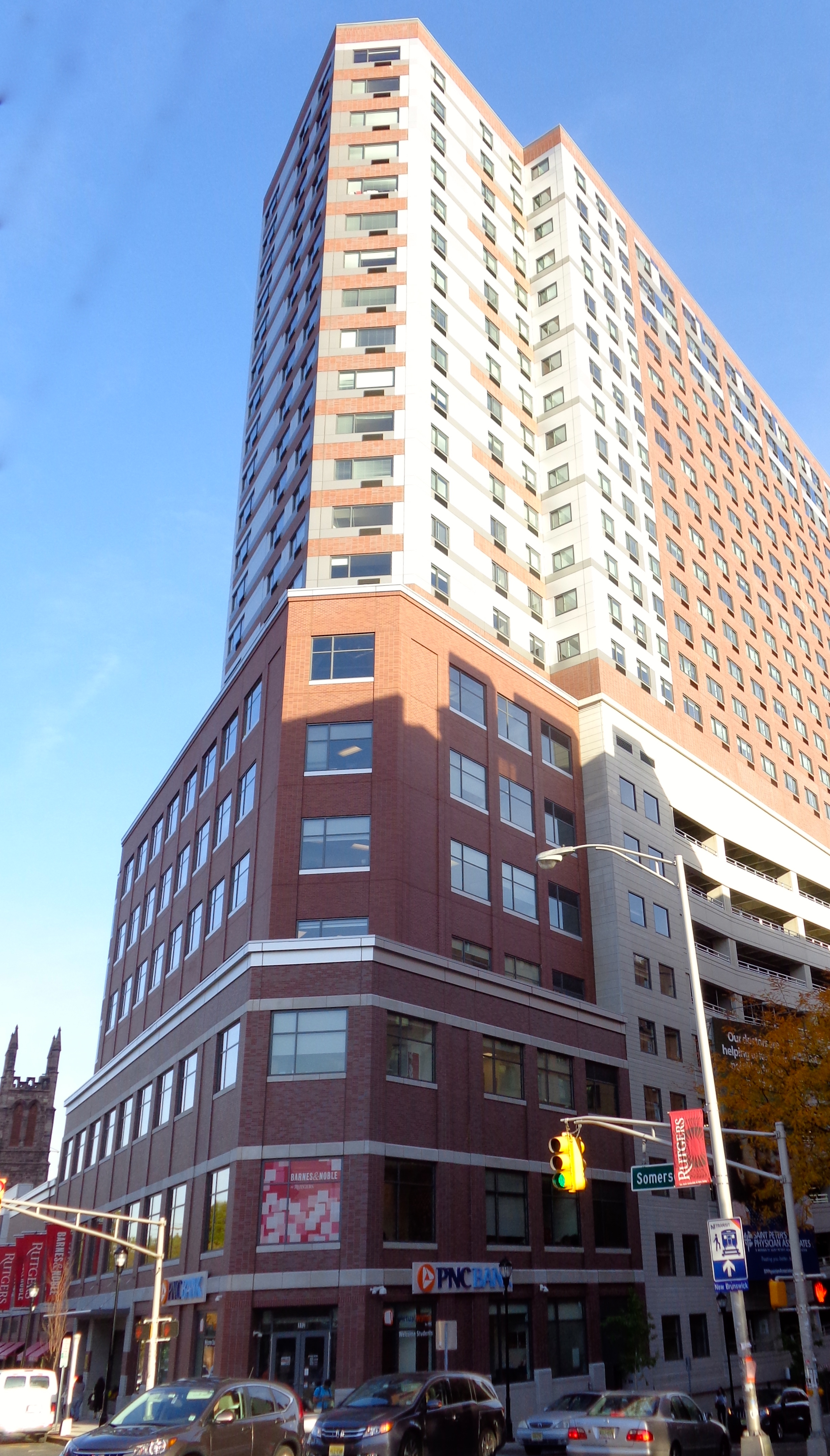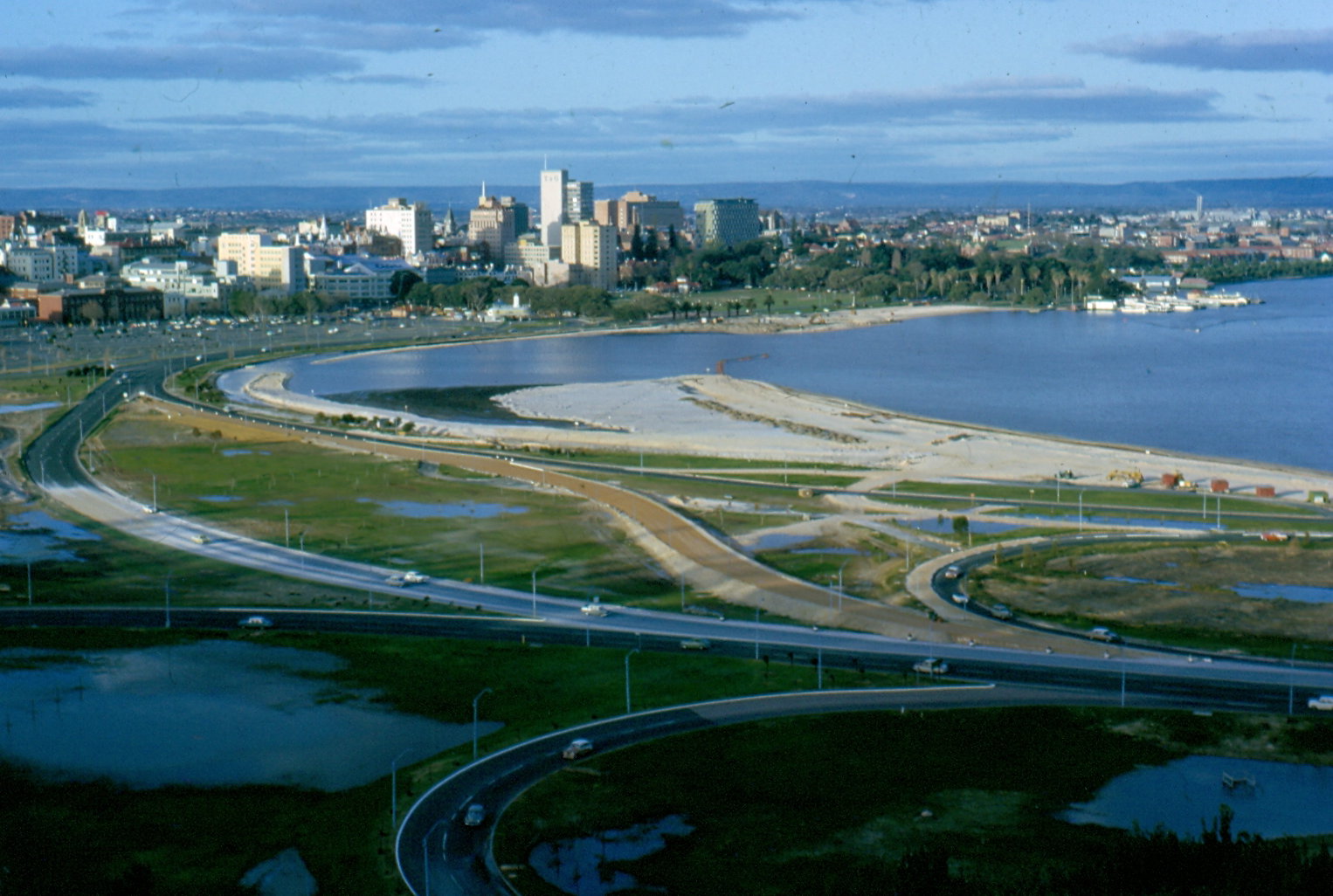|
Merihaka
Merihaka ( sv, Havshagen) is a coastal residential area in central Helsinki, Finland consisting of large high-rise concrete housing blocks. It is located by the Baltic Sea next to districts of Hakaniemi, Kallio and Sörnäinen. It is known for its tall, grey buildings. The residents of Merihaka tend to value highly the scenery, central location, tranquil atmosphere and lack of cars. The housing complex was built, partly on reclaimed land, during the 1970s and 1980s, and today it is home to some 2,300 people. A distinctive feature, shared with some other places in Helsinki such as Itä-Pasila, is traffic segregation: the streets for cars and buses together with large car parks are on a level of their own, below that of pedestrian footways and the main entrances to the buildings. This arrangement was to increase the cosiness of the area as well as improve traffic safety. The area has a central location, only about from the core of downtown Helsinki. Some flats with sea views com ... [...More Info...] [...Related Items...] OR: [Wikipedia] [Google] [Baidu] |
Hakaniemi
Hakaniemi (; sv, Hagnäs) is an unofficial district of Helsinki, the Finnish capital. It covers most of the neighbourhood of Siltasaari in the district of Kallio. Hakaniemi is located at the sea shore and is separated from the city centre by the Siltavuorensalmi strait and from the district of Linjat by the street Hämeentie. Historically, Hakaniemi was often associated with the working class and workers' associations. However, the cost of living has risen considerably in recent years and is now on par with that of the rest of central Helsinki. The main office of the Central Organisation of Finnish Trade Unions (SAK), the party offices of the Social Democratic Party of Finland (SDP) and the Left Alliance, as well as the Helsinki workers' house Paasitorni are located in Hakaniemi. The May Day march of the working class in Helsinki usually starts at the Hakaniemi market square. The best-known features of Hakaniemi include a large and lively marketplace, Oriental food stores with ... [...More Info...] [...Related Items...] OR: [Wikipedia] [Google] [Baidu] |
Sörnäinen
Sörnäinen ( sv, Sörnäs; ''Sörkkä'' or ''Sörkka'' in Helsinki slang) is a neighbourhood in the city of Helsinki, Finland. Sörnäinen is located a little more than one kilometre north from the coastal centre of Helsinki, near the district of Hakaniemi. The east side of Sörnäinen borders the sea. Sörnäinen used to be primarily an industrial district with many shipping companies and warehouses, however, nowadays it is a thriving urban area divided into four districts: Vilhonvuori, Kalasatama, Sompasaari and Hanasaari. It also has two metro stations: Sörnäinen metro station and Kalasatama metro station in the Kalasatama quarter. The headquarters of Senate Properties (''Senaatti-kiinteistöt'') is located in Sörnäinen. Also the Helsinki Prison located there. Etymology The name "Sörnäinen" comes from the Swedish name "''Södernäs''" ("Southern cape") and was first mentioned in the foundation document for the New Helsinki in 1639, although the name is probabl ... [...More Info...] [...Related Items...] OR: [Wikipedia] [Google] [Baidu] |
Kallio
Kallio (; sv, Berghäll; literally " the rock") is a district and a neighbourhood in Helsinki, the capital of Finland, located on the eastern side of the Helsinki peninsula about one kilometre north from the city centre. It is one of the most densely populated areas in Finland. Kallio is separated from the city centre by the Siltasaarensalmi strait, over which is a bridge called Pitkäsilta ("long bridge"). Traditionally, the bridge symbolizes the divide between the affluent centre and the more working class areas around Kallio. After the forming of the new centre in the 19th century, the city expanded northward. The intense industrialization which began in the 1860s in Helsinki saw the construction of the industrial areas around Sörnäinen harbour and to the workers' district of Kallio, with the area becoming inhabited mostly by factory workers. However, most of the working-class families have long ago been replaced as the most typical Kallio residents by young adults a ... [...More Info...] [...Related Items...] OR: [Wikipedia] [Google] [Baidu] |
Helsinki
Helsinki ( or ; ; sv, Helsingfors, ) is the Capital city, capital, primate city, primate, and List of cities and towns in Finland, most populous city of Finland. Located on the shore of the Gulf of Finland, it is the seat of the region of Uusimaa in southern Finland, and has a population of . The Helsinki urban area, city's urban area has a population of , making it by far the List of urban areas in Finland by population, most populous urban area in Finland as well as the country's most important center for politics, education, finance, culture, and research; while Tampere in the Pirkanmaa region, located to the north from Helsinki, is the second largest urban area in Finland. Helsinki is located north of Tallinn, Estonia, east of Stockholm, Sweden, and west of Saint Petersburg, Russia. It has History of Helsinki, close historical ties with these three cities. Together with the cities of Espoo, Vantaa, and Kauniainen (and surrounding commuter towns, including the eastern ... [...More Info...] [...Related Items...] OR: [Wikipedia] [Google] [Baidu] |
Finland
Finland ( fi, Suomi ; sv, Finland ), officially the Republic of Finland (; ), is a Nordic country in Northern Europe. It shares land borders with Sweden to the northwest, Norway to the north, and Russia to the east, with the Gulf of Bothnia to the west and the Gulf of Finland across Estonia to the south. Finland covers an area of with a population of 5.6 million. Helsinki is the capital and largest city, forming a larger metropolitan area with the neighbouring cities of Espoo, Kauniainen, and Vantaa. The vast majority of the population are ethnic Finns. Finnish, alongside Swedish, are the official languages. Swedish is the native language of 5.2% of the population. Finland's climate varies from humid continental in the south to the boreal in the north. The land cover is primarily a boreal forest biome, with more than 180,000 recorded lakes. Finland was first inhabited around 9000 BC after the Last Glacial Period. The Stone Age introduced several different ... [...More Info...] [...Related Items...] OR: [Wikipedia] [Google] [Baidu] |
Concrete
Concrete is a composite material composed of fine and coarse aggregate bonded together with a fluid cement (cement paste) that hardens (cures) over time. Concrete is the second-most-used substance in the world after water, and is the most widely used building material. Its usage worldwide, ton for ton, is twice that of steel, wood, plastics, and aluminum combined. Globally, the ready-mix concrete industry, the largest segment of the concrete market, is projected to exceed $600 billion in revenue by 2025. This widespread use results in a number of environmental impacts. Most notably, the production process for cement produces large volumes of greenhouse gas emissions, leading to net 8% of global emissions. Other environmental concerns include widespread illegal sand mining, impacts on the surrounding environment such as increased surface runoff or urban heat island effect, and potential public health implications from toxic ingredients. Significant research and developmen ... [...More Info...] [...Related Items...] OR: [Wikipedia] [Google] [Baidu] |
Apartment Block
A tower block, high-rise, apartment tower, residential tower, apartment block, block of flats, or office tower is a tall building, as opposed to a low-rise building and is defined differently in terms of height depending on the jurisdiction. It is used as a residential, office building, or other functions including hotel, retail, or with multiple purposes combined. Residential high-rise buildings are also known in some varieties of English, such as British English, as tower blocks and may be referred to as MDUs, standing for multi-dwelling units. A very tall high-rise building is referred to as a skyscraper. High-rise buildings became possible to construct with the invention of the elevator (lift) and with less expensive, more abundant building materials. The materials used for the structural system of high-rise buildings are reinforced concrete and steel. Most North American-style skyscrapers have a steel frame, while residential blocks are usually constructed of concr ... [...More Info...] [...Related Items...] OR: [Wikipedia] [Google] [Baidu] |
Land Reclamation
Land reclamation, usually known as reclamation, and also known as land fill (not to be confused with a waste landfill), is the process of creating new land from oceans, seas, riverbeds or lake beds. The land reclaimed is known as reclamation ground or land fill. In some jurisdictions, including parts of the United States, the term "reclamation" can refer to returning disturbed lands to an improved state. In Alberta, Canada, for example, reclamation is defined by the provincial government as "The process of reconverting disturbed land to its former or other productive uses." In Oceania, it is frequently referred to as land rehabilitation. History One of the earliest large-scale projects was the Beemster Polder in the Netherlands, realized in 1612 adding of land. In Hong Kong the Praya Reclamation Scheme added of land in 1890 during the second phase of construction. It was one of the most ambitious projects ever taken during the Colonial Hong Kong era.Bard, Solomon. ... [...More Info...] [...Related Items...] OR: [Wikipedia] [Google] [Baidu] |
Car Park
A parking lot (American English) or car park ( British English), also known as a car lot, is a cleared area intended for parking vehicles. The term usually refers to an area dedicated only for parking, with a durable or semi-durable surface. In most countries where cars are the dominant mode of transportation, parking lots are a feature of every city and suburban area. Shopping malls, sports stadiums, megachurches and similar venues often have immense parking lots. (See also: multistorey car park) Parking lots tend to be sources of water pollution because of their extensive impervious surfaces, and because most have limited or no facilities to control runoff. Many areas today also require minimum landscaping in parking lots to provide shade and help mitigate the extent to which their paved surfaces contribute to heat islands. Many municipalities require minimum numbers of parking spaces for buildings such as stores (by floor area) and apartment complexes (by numb ... [...More Info...] [...Related Items...] OR: [Wikipedia] [Google] [Baidu] |
Sidewalk
A sidewalk (North American English), pavement (British English), footpath in Australia, India, New Zealand and Ireland, or footway, is a path along the side of a street, highway, terminals. Usually constructed of concrete, pavers, brick, stone, or asphalt, it is designed for pedestrians. A sidewalk is normally higher than the roadway, and separated from it by a kerb (spelled "curb" in North America). There may also be a planted strip between the sidewalk and the roadway and between the roadway and the adjacent land. In some places, the same term may also be used for a paved path, trail or footpath that is not next to a road, for example, a path through a park. Terminology The term "sidewalk" is preferred in most of North America. The term "pavement" is more common in the United Kingdom and other members of the Commonwealth of Nations, as well as parts of the Mid-Atlantic United States such as Philadelphia and parts of New Jersey. Many Commonwealth countries use the term ... [...More Info...] [...Related Items...] OR: [Wikipedia] [Google] [Baidu] |






